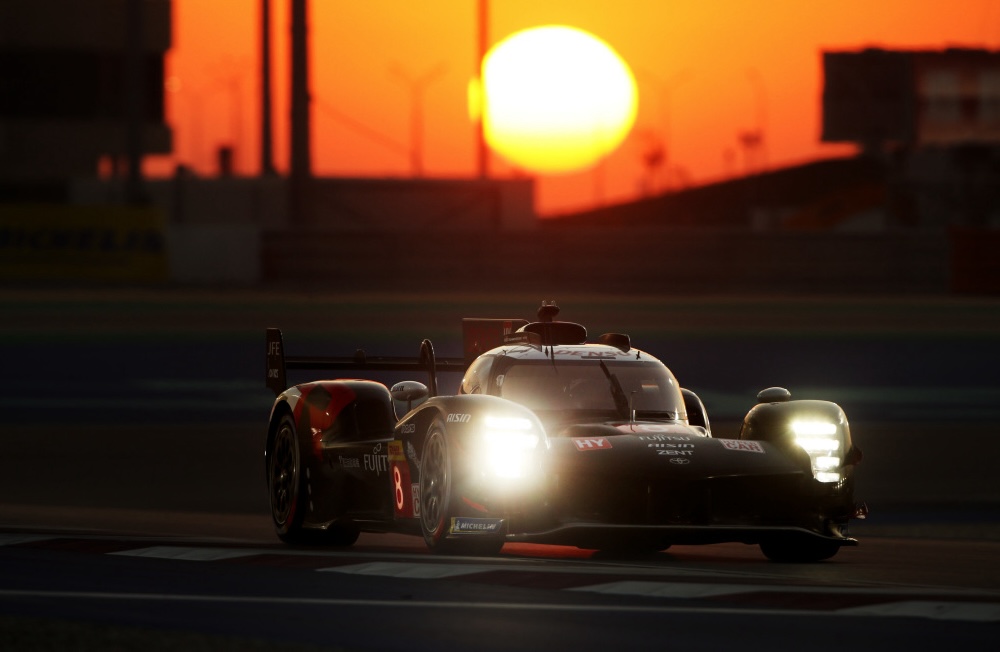Toyota Gazoo Racing has some tough decisions to make regarding the future of its Hypercar program, as the FIA World Endurance Championship’s future ruleset to accommodate hydrogen-powered prototypes takes shape.
Speaking with RACER in Qatar, Toyota Gazoo Racing’s chassis leader John Litjens explained that the Japanese manufacturer remains undecided on its strategy for life after the GR010. It has the choice of continuing to upgrade its current car until the hydrogen regulations debut or developing a brand-new one for the interim seasons after the GR010’s mandatory five-year homologation period ends.
This is a dilemma for Toyota, which is interested in racing a hydrogen-powered prototype but cannot make a final decision on a program because the timeline for the introduction of the regulations is not yet set. Currently, the ACO and FIA’s target is 2027 for the debut of the regulations — which are expected to accommodate both fuel cell and combustion technology — ahead of a planned shift to an all-hydrogen FIA WEC top class in 2030.
Is this realistic? Litjens is positive and feels the technology “should be” ready for use in top-class racing in time to meet the target. “Our colleagues in Japan are already running the Corolla on hydrogen and learning a lot there,” he said. “But it depends on how quickly the FIA comes up with the new regulations.”

The GR010 — now in its fourth season of competition — was heavily developed ahead of the 2023 WEC campaign, in which it won all but one of the races. As a result, the car has seen only minor updates ahead of the 2024 season. When asked about its plans for further upgrades to the GR010 for 2025 and development work on the next car, Litjens confirmed that work is being undertaken on both.
“We are looking at both, but we are discussing with the FIA about hydrogen regulations,” he said. “We have to keep our mind there. Yes at the moment we are at the top of the (performance) window, but if others make progress it could be too late.”
Assuming the WEC’s leap into hydrogen-powered racing is taken close to the proposed target date, the most likely scenario appears to be that Toyota would continue to race the GR010 until the new ruleset arrives.
“If the ruleset is not delayed too much we would hold on to the GR010, because if you do a full new car now and develop a hydrogen car in parallel, it would be too much,” Litjens explained. “For (the hydrogen rules to be introduced in) 2027 I think it should be OK, but if it gets 2029 or 2030 I think we have to do something in between.”
Progress, Litjens said, is being made on the regulations via a technical working group and that “the FIA are working hard” on it. He didn’t go into any detail but he did confirm that there is still more than one OEM seriously considering building a car for the new ruleset.
Is the other key player here Hyundai? The Korean manufacturer, which operates as a factory in the World Rally Championship, is known to be looking at sporting options to run parallel with its hydrogen roadmap for consumer vehicles.
Whatever happens, there are major hurdles for everyone involved to overcome. Leaving the timeframe for the ruleset’s debut aside, questions surrounding performance balancing, the maturity of the technology, the level of interest among current OEMs, the future of the current Hypercar ruleset, performance targets and proposed budgets all need answering.
Ideally, Litjens said, a hydrogen-powered Toyota would be able to race against cars competing in the LMH and LMDh ruleset, to ensure a healthy level of competition. However, he recognizes the complexity that would come with balancing LMH, LMDh and first-gen hydrogen-powered prototypes.
“If you see how long it took to get a bigger field (in Hypercar), I think the hydrogen we may have a few manufacturers that can come, but only with one or two cars because everything is new. I really think that the best first season to run is running Hypercar together with hydrogen cars, and then at a certain point switch.
“The most challenging aspect will be the weight of these cars,” he concluded. “I think it’s doable, but we can only judge it when we have more information.”

The FIA released a bulletin concerning hydrogen technology following the latest World Motor Sport Council meeting. It puts a spotlight on liquid hydrogen technology as a potential solution for motorsport applications.
While it doesn’t directly reference the forthcoming hydrogen category for the FIA WEC, it is clearly relevant for the OEMs helping shape the future of the championship and represents another small step towards clarity on the direction of the forthcoming regulations.
“As part of the FIA’s energy transition road map, which defines the gradual introduction of sustainable power sources in motorsport, the FIA continues development of hydrogen-fueled power units across different disciplines and competitions,” the statement read. “As the next phase, the FIA will focus its efforts on contribution to the development and promotion of solutions based on hydrogen stored in liquid form (LH2).
“Given the tank’s characteristics, lower volume and weight compared to compressed gas tanks (CGH2), liquid storage form is better suited to the demanding environment of motorsport competitions, where optimization is key. This also allows the powertrain layout to remain closer to the one of a conventional combustion-powered car compared with vehicles accommodating compressed gas tanks.
“Solutions utilizing compressed gas storage type will be considered as interim solutions, provided minimum safety and technical requirements are met.”
